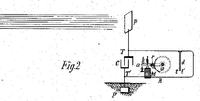
I found something like this:
See for yourself, maybe someone has already done some experiments to dispel this "myth"
Maybe this will interest someone?
I'm very interested in this topic, but I don't have time to test it right now
- PART 1 -
Tesla
Free Energy Receiver - fragments.
If you're a layman, think of it as a solar battery. Tesla's invention is completely different, but the closest thing to it in conventional technology is the photovoltaic cell. The important difference is that a conventional solar cell consists of a substrate coated with crystalline or, more recently, amorphous silicon. Conventional solar cells are expensive and, regardless of the coating, are manufactured in a secretive, guarded process.





But Tesla's solar panel is a shiny metal plate covered with a transparent insulating coating that today would be a synthetic spray coating. Put one such antenna-like panel high in the air, the higher the better, and connect it with a cable on one end to a capacitor and on the other to a good ground. Put some kind of breaker in parallel with the capacitor so that it discharges it with rhythmic pauses, and you're producing electricity. Tesla's patent tells us that getting electricity is so easy. The larger the area of the insulated plate, the more energy you get. But it's more than just a solar battery, because it doesn't necessarily need the sun to work. It also produces energy at night. Of course, according to official science, this is not possible. For this reason, you would not be able to obtain a patent for it today. Many inventors found out the hard way. Tesla had problems with the examiners of his patent, but today's inventor of free energy would have much worse. As of this writing, the US Patent Office is run by a former high-ranking executive of Phillips Petroleum, who was nominated by Reagan and took up the position immediately after leaving his former office.
Tesla's free energy receiver was patented in 1901 as the "Radiant Energy Utilization Apparatus". The patent applies "to the sun as well as other sources of radiant energy, such as cosmic rays." The fact that the device works at night is explained by the availability of cosmic rays during the night.
-------------------------------------------------- --------------------
- PART 2 -
See also this:
Excerpts from an article published on January 24, 1993 in the Dallas Morning News in the Texas Scetches column by AC Greene entitled "The Electric Auto that almost triumphed, Power Source of '31 car still a mystery."
[...] Several times earlier in this article I mentioned a man named Nikola Tesla and stated that he was the greatest mind that ever lived. The US Patent Office holds 1,200 patents registered in the name of Nikola Tesla, and it is estimated that he could patent an additional 1,000 from memory!
But, back to our electric cars - (in the spring of) 1931, under the financial aegis of Pierce-Arrow and George Westinghouse, the 1931 Pierce-Arrow was selected for testing at the factory site in Buffalo, New York. The standard combustion engine was removed from it and replaced with an 80 hp, 1,800 rpm electric motor, which was connected to the clutch and gearbox. The AC motor was 40 inches long and 30 inches in diameter, and its power cords were left sticking out into the air - no external power source.
At the appointed time, Nicola Tesla arrived from New York and inspected the Pierce-Arrow car. Then he went to the nearest radio shop and bought a handful (12) of vacuum tubes (type 70-L-7 --- source: http://www.evworld.com/view.cfm?section=article&storyid=1062), wires and selected resistors. He placed the constructed circuit in a box that was 24 inches long, 12 inches wide, and 6 inches high. The box was placed in the front seat and its wires were connected to an air-cooled, brushless motor. A 1.8 m long antenna and two 1/4 inch diameter rods protruded 3 inches from the box.
Mr. Tesla sat in the driver's seat, stuffed the rods into the box, and said "now we have power." He put it in gear and off he went! This vehicle powered by an AC motor reached speeds of up to 90 mph. And it behaved better than any internal combustion engine car of its time. Tesla spent a whole week in this car. Several newspapers in Buffalo covered the ordeal. When asked where Tesla's power came from, he replied "From the Ether that surrounds us." Several people suggested that Tesla had gone mad and colluded with the sinister forces of the universe. This infuriated Tesla, he removed his mystery box from the vehicle and returned to his laboratory in New York City. He took his secret to the grave!
It is supposed that Tesla was somehow able to use the earth's magnetic field that covers our planet. And somehow receive huge amounts of energy by crossing these lines or having them multiply with each other. The exact nature of this device remains a mystery, but it actually worked by powering an 80 hp Pierce-Arrow engine to a speed of 90 mph. without any loading.


